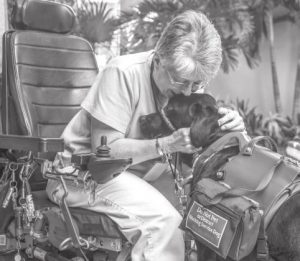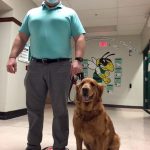A helping paw
April 1, 2020

The health care needs of each person are multifaceted, consisting of various factors that makes everyone unique.
Therefore, effective health care requires collaboration between various professionals to support healthy and meaningful lives. We celebrate April as National Occupational Therapy Month. Occupational therapists (OTs) play an important role across the lifespan in a child’s development or an individual’s recovery and integration into society after a life changing incident. Occupations are everyday life activities, from brushing our teeth to navigating the SunRail after work. OTs work closely with clients to provide individualized skilled services, empowering individuals to feel confident participating in everyday activities. Various interventions are associated with this profession, including those cute animals in vests you may have seen around. The terms service animals, emotional support animals (ESAs), and therapy dogs are frequently seen as interchangeable. However, these animals have different training, rights and roles. Service animals are specifically trained to work with individuals with disabilities, aiding with tasks directly related to the disability— picking up a dropped item for an individual with Parkinson’s Disease, alerting an individual with hearing impairments when someone is at the door, guiding an individual with low vision across the crosswalk, and even detecting changes in blood sugar for those with diabetes. Service animals are covered under Title II and III of the Americans with Disabilities Act (ADA), meaning they are allowed in every public setting to assist the individual with the disability. However, under the ADA, only dogs can be considered service animals. Conversely, ESAs and therapy dogs are not covered under the ADA. They are not necessarily afforded the same rights to access in public facilities, but can still play a crucial role in providing emotional support and alleviating stress or anxiety. Nevertheless, they do not require any specific training. Unlike service animals, ESAs include a wide array of unique animals, such as birds, rabbits and turtles. Technically, any animal can be considered an ESA, but they require a letter from a licensed health-care professional confirming the individual has a disability and that the ESA would be beneficial for their disability. Therapy dogs, on the other hand, require more training to interact with a variety of people. Therapy dogs are certified as they often travel to places such as hospitals, libraries, and schools to provide emotional support. OTs can play a special role in integrating therapy dogs into their practice with animal-assisted therapy. OTs can also assist individuals with disabilities on how to care for their service animal and incorporate them into their daily routines. As tempting as it may be to pet these animals when you see them in public, it is important to remember that they are performing essential jobs for their owners and not to distract them. Avoid talking, feeding, or petting animals without asking for consent from their owner. Despite whether the animal walks up to you or not, it is imperative you speak directly to the handler and ask for permission first. These animals typically wear vests, reminding others not to pet or touch them. Remember, individuals with service animals utilize them to manage a health condition; they may not want to draw public attention. Therefore, weigh whether it is worth speaking to the owner or appreciate the animal’s service from afar.
Register your Dog Schedule a Visit

 When middle school students return to class on Jan. 11, they’ll find a new face at the door: Daisy. Daisy is a therapy dog and the personal pet of Rob Kreger, principal of the Rock L. Butler Middle School. The five-year-old golden retriever is not a school pet or mascot, but rather a working dog […]
When middle school students return to class on Jan. 11, they’ll find a new face at the door: Daisy. Daisy is a therapy dog and the personal pet of Rob Kreger, principal of the Rock L. Butler Middle School. The five-year-old golden retriever is not a school pet or mascot, but rather a working dog […] Last March, Caroline Benzel, a third-year medical student, began to notice the stress and discomfort her nurse friends were feeling from the pressures of the ongoing Covid-19 pandemic. “[Personal protective equipment] can be really rough on the skin,” Benzel, 31, tells PEOPLE. Benzel and her 3-year-old Rottweiler, Loki (who’s also a therapy dog) hatched a […]
Last March, Caroline Benzel, a third-year medical student, began to notice the stress and discomfort her nurse friends were feeling from the pressures of the ongoing Covid-19 pandemic. “[Personal protective equipment] can be really rough on the skin,” Benzel, 31, tells PEOPLE. Benzel and her 3-year-old Rottweiler, Loki (who’s also a therapy dog) hatched a […] When Stanley the miniature fox terrier’s owner passed away, the little dog started a ‘paw-some’ new role – bringing puppy love to some of the Gold Coast’s oldest residents. After Carinity Cedarbrook Diversional Therapist Julianne Staff adopted Stanley, he began visiting the aged care community at Mudgeeraba as a therapy dog. Therapy dogs help to […]
When Stanley the miniature fox terrier’s owner passed away, the little dog started a ‘paw-some’ new role – bringing puppy love to some of the Gold Coast’s oldest residents. After Carinity Cedarbrook Diversional Therapist Julianne Staff adopted Stanley, he began visiting the aged care community at Mudgeeraba as a therapy dog. Therapy dogs help to […] Those who own a dog can attest to their ability to lift mood, improve stress and bring joy by simply being there, unanswering, seemingly all-knowing and always delighted to see you. Therapy animals are known for their calm and comforting nature, giving people a way to relax, de-stress and interact with a loving pet. They […]
Those who own a dog can attest to their ability to lift mood, improve stress and bring joy by simply being there, unanswering, seemingly all-knowing and always delighted to see you. Therapy animals are known for their calm and comforting nature, giving people a way to relax, de-stress and interact with a loving pet. They […] For those of us with dogs, we know they quickly become major parts of the family. You live for and care for just like one of your own children, and one dog right here in Oklahoma City is beating the odds, and helping others recover as a therapy dog, despite all of the issues he’s […]
For those of us with dogs, we know they quickly become major parts of the family. You live for and care for just like one of your own children, and one dog right here in Oklahoma City is beating the odds, and helping others recover as a therapy dog, despite all of the issues he’s […] Cherokee Middle School students may do a little more “doodling” second semester starting this month (January), but also will improve their attendance marks because of a special attraction at the school, courtesy of Principal Scott Aden. Aden, an effective, caring administrator, has acquired and will house and handle a young female Golden Doodle (Charlie) that […]
Cherokee Middle School students may do a little more “doodling” second semester starting this month (January), but also will improve their attendance marks because of a special attraction at the school, courtesy of Principal Scott Aden. Aden, an effective, caring administrator, has acquired and will house and handle a young female Golden Doodle (Charlie) that […] E5 Therapy opened in April with a different way to help veterans in therapy. They offer canine-assisted therapy along with talk therapy to veterans and veterans’ families in Solano County. Owner Matthew Decker is a licensed clinical social worker in Northern California, focused on helping veterans achieve their mental health goals. Along with his team, […]
E5 Therapy opened in April with a different way to help veterans in therapy. They offer canine-assisted therapy along with talk therapy to veterans and veterans’ families in Solano County. Owner Matthew Decker is a licensed clinical social worker in Northern California, focused on helping veterans achieve their mental health goals. Along with his team, […]